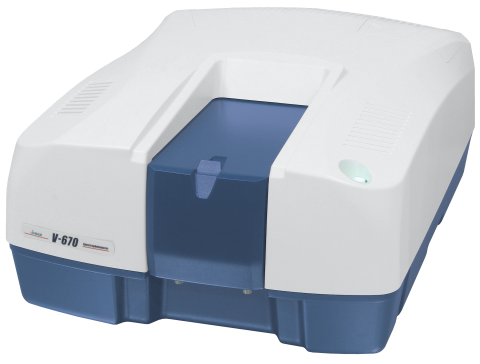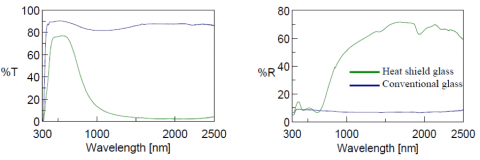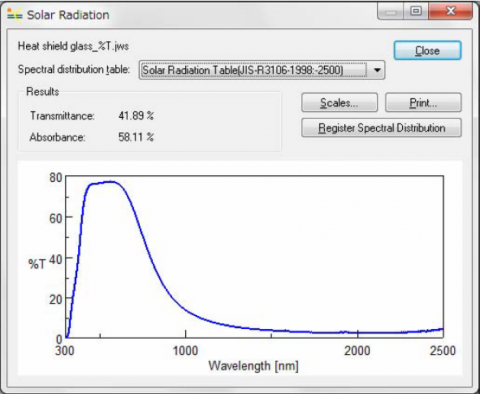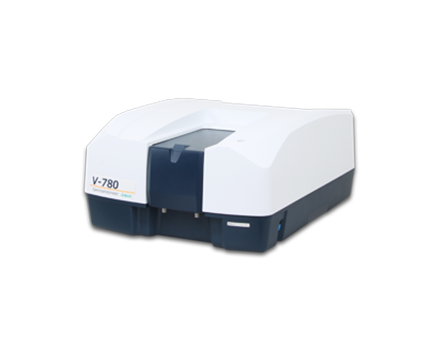Evaluation of Solar Heat Gain Coefficient and Transmittance, Reflectance & Emittance Measurement of Flat Glass by UV-Visible/NIR Spectroscopy
January 4, 2024
Introduction

Heat shield glass is typically made from eco-friendly materials that help in the prevention of global warming and reduction in energy costs. Testing methods for the evaluation of heat shield glass is stipulated by JIS R3016 and require visible transmittance, visible reflectance, solar transmittance, solar reflectance, and emittance measurements. From these measurements, the solar heat gain coefficient can be calculated, which is defined as the fraction of incident solar radiation admitted through a window.
This application note shows how to obtain and evaluate transmittance/reflectance spectra of a flat glasses using an integrating sphere and calculate the solar radiation absorbance using the Solar Transmittance/Reflectance Visible Light Transmittance/Reflectance program.
Experimental
| Measurement Conditions | |||
| Measurement Range | 2500-300nm | Data Pitch | 0.5 nm |
| UV/Vis Bandwidth | 5.0 nm | NIR Bandwidth | 25.0 nm |
| Scan Speed | 400 nm/min | Response | Fast |
Keywords
190-RF-0217, V-670, UV-Visible/NIR, ISN-723 Integrating sphere, VWST-774 Solar Transmittance/Reflectance Visible Light Transmittance/Reflectance program, solar heat gain
Results
Spectra of both heat shield glass and conventional glass were measured and are shown in Figure 1.

The solar radiation results of the heat shield and conventional glass were calculated using the Solar Transmittance/Reflectance Visible Light Transmittance/Reflectance program and are shown in Figure 2 and Table 1.

| Heat Shield Glass % | Conventional Glass % | |
| Solar Radiation Transmittance | 41.89 | 86.10 |
| Solar Radiation Reflectance | 31.85 | 7.82 |
| Solar Radiation Absorbance | 26.26 | 6.08 |
| Visible Light Transmittance | 76.38 | 89.95 |
| Visible Light Reflectance | 8.80 | 8.52 |
Featured Products:
-

Wide range UV-Visible/Near Infrared Spectrophotometer with PbS detector for wavelengths up to 3200nm
V-770 UV-Visible/NIR Spectrophotometer
-

A high sensitivity UV-Visible/NIR Spectrophotometer with InGaAs detector for wavelengths up to1600nm
V-780 UV-Visible/NIR Spectrophotometer

Evaluation of Solar Heat Gain Coefficient and Transmittance, Reflectance & Emittance Measurement of Flat Glass by UV-Visible/NIR Spectroscopy
Introduction

Heat shield glass is typically made from eco-friendly materials that help in the prevention of global warming and reduction in energy costs. Testing methods for the evaluation of heat shield glass is stipulated by JIS R3016 and require visible transmittance, visible reflectance, solar transmittance, solar reflectance, and emittance measurements. From these measurements, the solar heat gain coefficient can be calculated, which is defined as the fraction of incident solar radiation admitted through a window.
This application note shows how to obtain and evaluate transmittance/reflectance spectra of a flat glasses using an integrating sphere and calculate the solar radiation absorbance using the Solar Transmittance/Reflectance Visible Light Transmittance/Reflectance program.
Experimental
| Measurement Conditions | |||
| Measurement Range | 2500-300nm | Data Pitch | 0.5 nm |
| UV/Vis Bandwidth | 5.0 nm | NIR Bandwidth | 25.0 nm |
| Scan Speed | 400 nm/min | Response | Fast |
Keywords
190-RF-0217, V-670, UV-Visible/NIR, ISN-723 Integrating sphere, VWST-774 Solar Transmittance/Reflectance Visible Light Transmittance/Reflectance program, solar heat gain
Results
Spectra of both heat shield glass and conventional glass were measured and are shown in Figure 1.

The solar radiation results of the heat shield and conventional glass were calculated using the Solar Transmittance/Reflectance Visible Light Transmittance/Reflectance program and are shown in Figure 2 and Table 1.

| Heat Shield Glass % | Conventional Glass % | |
| Solar Radiation Transmittance | 41.89 | 86.10 |
| Solar Radiation Reflectance | 31.85 | 7.82 |
| Solar Radiation Absorbance | 26.26 | 6.08 |
| Visible Light Transmittance | 76.38 | 89.95 |
| Visible Light Reflectance | 8.80 | 8.52 |

 Download This Application
Download This Application